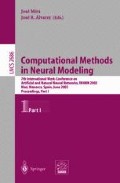Abstract
In this paper, we study the blind source separation problem of temporally correlated signals via exploring both the temporal structure and high-order statistics of source signals. First, we formulate the problem as independent residual analysis and present a simple cost function. Efficient learning algorithm is developed for the demixing matrix and the corresponding stability analysis is also provided. The formulation provides much more exibility for us to identify learning algorithms with good learning performance and stability. Furthermore, the approach unifies the conventional high-order statistical method and the second-order statistical method. From stability analysis, we infer that if the temporal filters of sources are mutually different, the second order statistical algorithm will be sufficient to separate the sources from their linear mixtures.
Corresponding author
Access this chapter
Tax calculation will be finalised at checkout
Purchases are for personal use only
Preview
Unable to display preview. Download preview PDF.
References
S. Amari. Natural gradient works efficiently in learning. Neural Computation, 10:251–276, 1998.
S. Amari and J.-F. Cardoso. Blind source separation-semiparametric statistical approach. IEEE Trans. Signal Processing, 45:2692–2700, Nov. 1997.
S. Amari, A. Cichocki, and H.H. Yang. A new learning algorithm for blind signal separation. In G. Tesauro, D.S. Touretzky, and T.K. Leen, editors, Advances in Neural Information Processing Systems 8 (NIPS*95), pages 757–763, 1996.
A.J. Bell and T.J. Sejnowski. An information maximization approach to blind separation and blind deconvolution. Neural Computation, 7:1129–1159, 1995.
A. Belouchrani, K. Abed-Meraim, J.-F. Cardoso, and E. Moulines. A blind source separation technique using second order statistics. IEEE Trans. Signal Processing, 45:434–444, 1997.
J.-F. Cardoso and B. Laheld. Equivariant adaptive source separation. IEEE Trans. Signal Processing, SP-43:3017–3029, Dec 1996.
P. Comon. Independent component analysis: a new concept? Signal Processing, 36:287–314, 1994.
A. Hyvarinen and E. Oja. A fast fixed-point algorithm for independent component analysis. Neural Computation, 9(7):1483–1492, 1997.
C. Jutten and J. Herault. Blind separation of sources, Part I: An adaptive algorithm based on neuromimetic architecture. Signal Processing, 24:1–10, 1991.
T.W. Lee, M. Girolami, and T. Sejnowski. Independent component analysis using an extended infomax algorithm for mixed subgaussian and supergaussian sources. Neural Computation, 11:417–41, 1999.
L. Zhang, S. Amari, and A. Cichocki. Semiparametric model and superefficiency in blind deconvolution. Signal Processing, pages 2535–2553, 2001.
L. Zhang, A. Cichocki, and S. Amari. Natural gradient algorithm for blind separaiton of overdetermined mixture with additive noise. IEEE Signal Processing Letters, 6(11):293–295, 1999.
Author information
Authors and Affiliations
Editor information
Editors and Affiliations
Rights and permissions
Copyright information
© 2003 Springer-Verlag Berlin Heidelberg
About this paper
Cite this paper
Zhangy, LQ., Cichockiz, A. (2003). Independent Residual Analysis for Temporally Correlated Signals. In: Mira, J., Álvarez, J.R. (eds) Computational Methods in Neural Modeling. IWANN 2003. Lecture Notes in Computer Science, vol 2686. Springer, Berlin, Heidelberg. https://doi.org/10.1007/3-540-44868-3_21
Download citation
DOI: https://doi.org/10.1007/3-540-44868-3_21
Published:
Publisher Name: Springer, Berlin, Heidelberg
Print ISBN: 978-3-540-40210-7
Online ISBN: 978-3-540-44868-6
eBook Packages: Springer Book Archive

